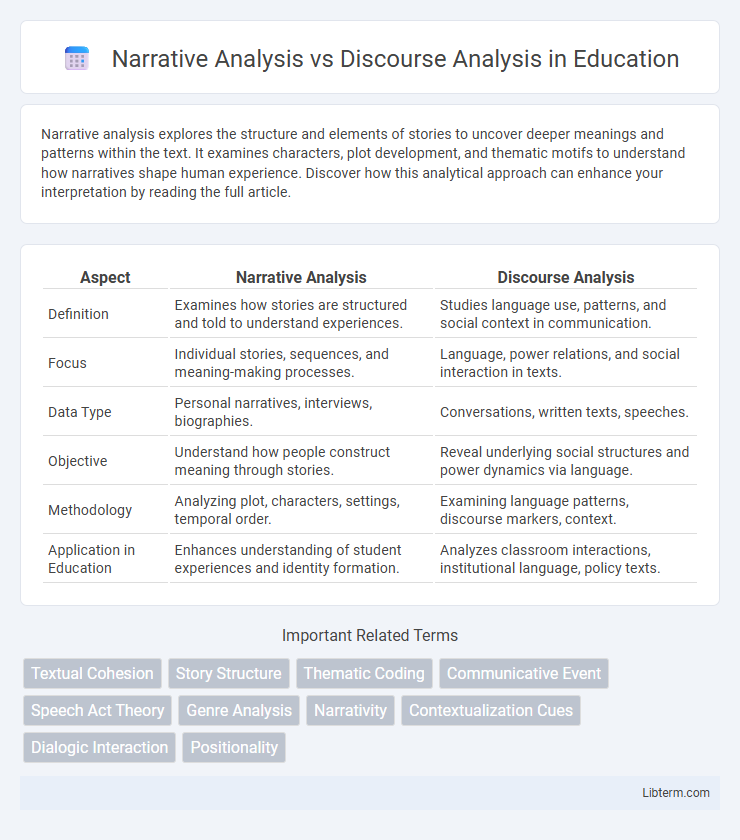Narrative analysis explores the structure and elements of stories to uncover deeper meanings and patterns within the text. It examines characters, plot development, and thematic motifs to understand how narratives shape human experience. Discover how this analytical approach can enhance your interpretation by reading the full article.
Table of Comparison
| Aspect | Narrative Analysis | Discourse Analysis |
|---|---|---|
| Definition | Examines how stories are structured and told to understand experiences. | Studies language use, patterns, and social context in communication. |
| Focus | Individual stories, sequences, and meaning-making processes. | Language, power relations, and social interaction in texts. |
| Data Type | Personal narratives, interviews, biographies. | Conversations, written texts, speeches. |
| Objective | Understand how people construct meaning through stories. | Reveal underlying social structures and power dynamics via language. |
| Methodology | Analyzing plot, characters, settings, temporal order. | Examining language patterns, discourse markers, context. |
| Application in Education | Enhances understanding of student experiences and identity formation. | Analyzes classroom interactions, institutional language, policy texts. |
Introduction to Narrative Analysis and Discourse Analysis
Narrative Analysis examines the structure and content of stories to understand how individuals or groups make sense of experiences, emphasizing temporal sequences and characters' roles. Discourse Analysis investigates language use in social contexts, focusing on how power, identity, and meaning are constructed through communication patterns and interaction. Both approaches provide critical insights into textual and conversational data, with Narrative Analysis centering on storytelling frameworks and Discourse Analysis on language dynamics in social settings.
Defining Narrative Analysis
Narrative analysis examines how stories are structured, focusing on the sequencing of events and the roles of characters to understand how meaning is constructed within a text. It investigates the plot, temporal order, and the perspectives presented to reveal the underlying themes and cultural contexts embedded in personal or collective narratives. This methodology is distinct from discourse analysis, which primarily studies language use, power relations, and social interactions beyond the story framework.
Defining Discourse Analysis
Discourse Analysis examines language in use across social contexts, focusing on how meaning is constructed through communication, power relations, and cultural norms within texts and conversations. It studies structures beyond the sentence level, including spoken, written, and visual communication, to uncover underlying social practices and ideologies. In contrast, Narrative Analysis specifically investigates how stories are structured and told to convey experiences and identities.
Core Differences Between Narrative and Discourse Analysis
Narrative analysis focuses on the structured storytelling elements within texts, examining the plot, characters, and temporal sequence to interpret meaning. Discourse analysis investigates language use in social contexts, emphasizing power dynamics, communication patterns, and sociocultural influences embedded in interaction. Core differences lie in narrative analysis prioritizing story construction and individual experiences, while discourse analysis centers on language functions and broader social practices.
Research Objectives: When to Use Narrative vs. Discourse Analysis
Narrative Analysis focuses on understanding how individuals construct meaning through personal stories, making it ideal for exploring identity, memory, and lived experiences. Discourse Analysis examines language use in social contexts to uncover power relations, ideologies, and social structures, suited for analyzing communication patterns and cultural norms. Choose Narrative Analysis for research centered on individual perspectives and life stories, while Discourse Analysis fits studies investigating interaction, social practices, or institutional language.
Data Collection Methods in Narrative and Discourse Analysis
Narrative analysis primarily collects data through personal stories, interviews, and autobiographical accounts to explore how individuals construct meaning through storytelling. Discourse analysis gathers data from naturally occurring language in conversations, texts, and social interactions to examine how language functions in social contexts. Both methods utilize qualitative techniques, but narrative analysis centers on content and sequence of stories, while discourse analysis focuses on language use, patterns, and power dynamics within communication.
Analytical Techniques: Narrative Structures vs. Language Use
Narrative analysis examines the structure of stories, focusing on elements like plot, characters, and temporal sequencing to understand how meaning is constructed within narratives. Discourse analysis investigates language use, emphasizing patterns, power relations, and context-dependent communication across spoken or written text. These analytical techniques highlight the difference between analyzing narrative structures and exploring linguistic features to interpret social and cultural phenomena.
Applications in Social Sciences and Humanities
Narrative Analysis is widely employed in social sciences and humanities to examine how individuals construct personal and collective identities through storytelling, providing insights into cultural norms and social experiences. Discourse Analysis focuses on language use in social contexts, revealing power dynamics, ideologies, and social structures embedded in communication patterns across institutions and media. Both methodologies offer complementary tools for analyzing meaning-making processes, with Narrative Analysis emphasizing sequence and temporality, while Discourse Analysis highlights interaction and context.
Strengths and Limitations of Each Approach
Narrative analysis excels at uncovering personal stories and the meaning individuals assign to their experiences, providing rich, contextual insights but can be limited by subjectivity and difficulties in generalizing findings. Discourse analysis offers a broader examination of language use in social contexts, revealing power dynamics and societal structures through patterns in communication, though it often requires complex, interpretive skills and may overlook individual emotional nuances. Both approaches complement each other by balancing depth in personal narratives with the structural lens of discourse, yet each faces challenges in balancing depth with breadth and interpretive rigor with empirical validation.
Conclusion: Selecting the Right Analytical Method
Choosing between narrative analysis and discourse analysis depends on research goals: narrative analysis excels in exploring individual experiences and story structures, while discourse analysis focuses on language use and power dynamics within social contexts. Researchers aiming to understand personal meaning and identity construction benefit from narrative analysis, whereas those examining communication patterns and social interactions should opt for discourse analysis. Aligning the analytical method with the study's objective enhances the validity and depth of qualitative insights.
Narrative Analysis Infographic

 libterm.com
libterm.com